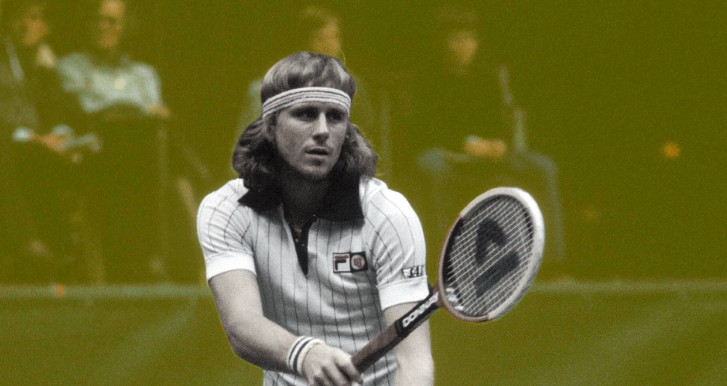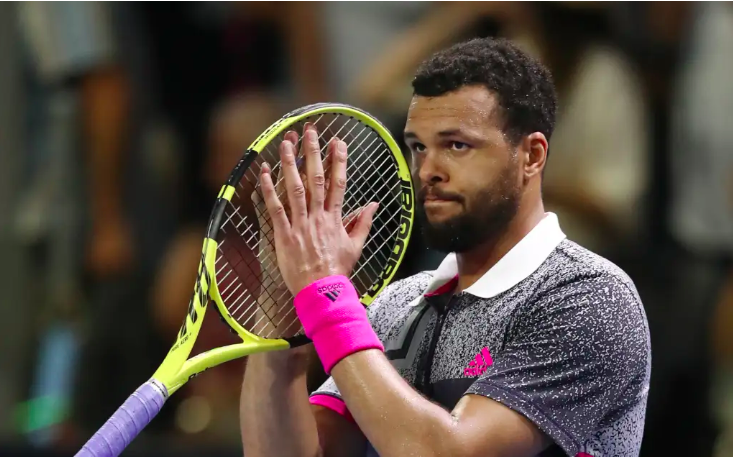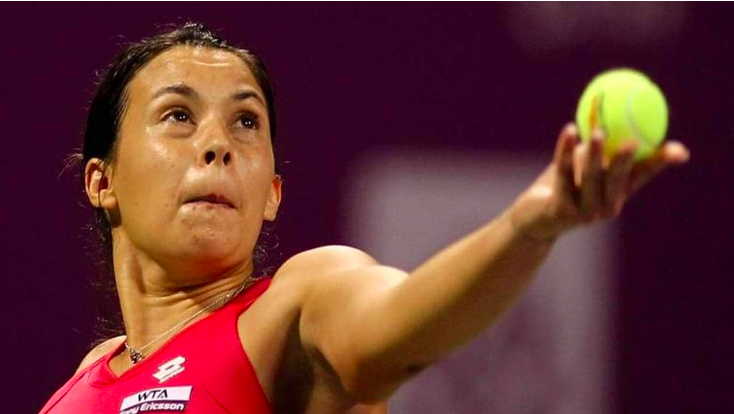Tennis
Bjorn Borg: The Ice Man Who Conquered Tennis with Unyielding Coolness

Bjorn Borg: The Ice Man Who Conquered Tennis with Unyielding Coolness
The Legendary Bjorn Borg
Bjorn Borg, often referred to as “The Ice Man,” is a name that resonates with tennis enthusiasts around the world. Known for his calm demeanor and exceptional performance, particularly at Wimbledon and the French Open, Borg’s impact on the sport is monumental. His cool composure on the court, combined with his remarkable skill set, has earned him a legendary status in tennis history.
This article delves into the life, career, and enduring legacy of Bjorn Borg, exploring how his unique approach to the game made him one of the greatest tennis players of all time.
Early Life and Beginnings
A Tennis Prodigy
Bjorn Rune Borg was born on June 6, 1956, in Sodertalje, Sweden. His introduction to tennis came early when his father, Rune, won a tennis racket in a table tennis tournament. The young Bjorn was instantly captivated by the sport and began practicing rigorously. His natural talent and dedication quickly became evident, setting the stage for a remarkable career.
Junior Success
By the age of 13, Borg had already made a name for himself in the junior circuit, winning the Swedish National Junior Championship. His powerful groundstrokes and unparalleled mental toughness set him apart from his peers. Borg’s early success in junior tournaments foreshadowed his future dominance in professional tennis.
Turning Professional
Early Years on the Tour
Bjorn Borg turned professional in 1973, at the age of 16. His entry into the professional circuit was met with immediate success. By 1974, he had won his first ATP title in Auckland, New Zealand. Borg’s relentless drive and exceptional skills quickly propelled him up the rankings, and he soon became a force to be reckoned with on the tour.
Breakthrough at the French Open
Borg’s breakthrough came in 1974 when he won his first Grand Slam title at the French Open. At just 18 years old, he defeated Manuel Orantes in the final, showcasing his dominance on clay courts. This victory marked the beginning of Borg’s illustrious career and his love affair with Roland Garros.
The Dominance at Wimbledon
First Wimbledon Title
In 1976, Bjorn Borg won his first Wimbledon title, defeating Ilie Năstase in straight sets. His victory at the All England Club was a testament to his versatility and adaptability on grass courts. Borg’s calm and composed demeanor earned him the nickname “The Ice Man,” as he remained unflustered under pressure.
Wimbledon Streak
Borg’s dominance at Wimbledon continued as he won five consecutive titles from 1976 to 1980. His epic battles with John McEnroe, particularly the 1980 final, are etched in tennis history. Borg’s ability to remain focused and composed, even in the face of intense competition, solidified his legendary status.
Mastery of the French Open
Six French Open Titles
Bjorn Borg’s prowess on clay was unmatched. He won six French Open titles between 1974 and 1981, a record at the time. His powerful baseline game, coupled with his incredible stamina, made him virtually unbeatable on the red clay of Roland Garros. Borg’s success at the French Open is a testament to his technical brilliance and strategic acumen.
The Borg vs. Vilas Rivalry
One of the highlights of Borg’s career was his rivalry with Guillermo Vilas. Their battles on clay courts were legendary, with Borg often coming out on top. This rivalry pushed both players to their limits and provided some of the most memorable moments in tennis history.
Playing Style and Technique
The Two-Handed Backhand
Borg’s two-handed backhand was one of his most formidable weapons. Unlike many of his contemporaries who favored a one-handed backhand, Borg’s use of both hands allowed for greater control and power. This shot was particularly effective on clay, where he could generate heavy topspin to keep his opponents on the defensive.
Fitness and Endurance
Borg’s exceptional fitness and endurance were key components of his success. His rigorous training regimen and dedication to physical conditioning gave him a significant advantage, allowing him to outlast opponents in grueling matches. Borg’s ability to maintain a high level of performance throughout long rallies and matches was unparalleled.
Mental Toughness
Borg’s mental toughness set him apart from other players. His ability to stay calm and composed, even in high-pressure situations, earned him the nickname “The Ice Man.” This mental fortitude was crucial in his success, enabling him to perform at his best during crucial moments.
Records and Achievements
Grand Slam Titles
Bjorn Borg won a total of 11 Grand Slam singles titles during his career. His achievements include five Wimbledon titles and six French Open titles. Borg’s success across different surfaces showcased his versatility and adaptability, making him one of the most well-rounded players in tennis history.
World No. 1
Borg held the World No. 1 ranking for a total of 109 weeks. His sustained excellence at the highest level of the sport is a testament to his consistency and dominance. Borg’s ability to maintain his top position in the rankings over an extended period highlights his exceptional skill and determination.
Davis Cup Success
Borg also had significant success in the Davis Cup, leading Sweden to victory in 1975. His contributions to the Swedish team were instrumental in their triumph, further cementing his status as a tennis legend. Borg’s commitment to representing his country added to his legacy as a true champion.
Rivalries and Memorable Matches
Borg vs. McEnroe
The rivalry between Bjorn Borg and John McEnroe is one of the most storied in tennis history. Their contrasting styles and personalities created a captivating dynamic on the court. The 1980 Wimbledon final, often regarded as one of the greatest matches ever played, epitomized this rivalry. Borg’s victory in this epic five-set battle is remembered as a defining moment in his career.
Borg vs. Connors
Another significant rivalry in Borg’s career was with Jimmy Connors. Their matches were characterized by intense competition and high-quality tennis. Borg’s victories over Connors in major finals, including the US Open and Wimbledon, were crucial in establishing his dominance during his peak years.
Personal Life and Post-Retirement
Early Retirement
In 1983, at the age of 26, Bjorn Borg shocked the tennis world by announcing his retirement. Despite his young age, Borg felt he had achieved all he wanted in the sport and decided to step away from professional tennis. His early retirement left fans and pundits wondering what more he could have achieved had he continued playing.
Business Ventures
After retiring from tennis, Borg pursued various business ventures. He launched his own fashion line, Bjorn Borg, which became popular in Europe. His entrepreneurial spirit and ability to reinvent himself outside of tennis showcased his versatility and adaptability.
Return to Tennis
In the early 1990s, Borg made a brief return to professional tennis. Although he did not achieve the same level of success as in his prime, his comeback was a testament to his enduring love for the sport. Borg’s return generated significant media attention and highlighted the lasting impact he had on tennis.
Legacy and Impact
Influence on Future Generations
Bjorn Borg’s influence extends far beyond his own career. His success and approach to the game have inspired countless young players to pursue excellence in tennis. Borg’s calm demeanor, strategic brilliance, and dedication to fitness set a standard for future generations.
Contributions to Tennis
Even after retiring, Borg has remained involved in the tennis community. He has participated in exhibition matches, charity events, and various initiatives aimed at promoting the sport. Borg’s contributions continue to be recognized and celebrated, ensuring his legacy endures.
Personal Life and Philanthropy
Borg’s personal life has also been marked by his commitment to philanthropy. He has supported various charitable causes and initiatives, reflecting his character and values. Borg’s dedication to giving back to the community further cements his legacy as a true ambassador of tennis.
Conclusion: The Enduring Legacy of Bjorn Borg
Bjorn Borg’s career is a testament to excellence, determination, and resilience. His cool demeanor and exceptional performance, particularly at Wimbledon and the French Open, have left an indelible mark on the sport.
Borg’s legacy is not only defined by his records and titles but also by the inspiration he provides to future generations. As we celebrate his contributions to tennis, we recognize Bjorn Borg as one of the greatest players in the history of the game.
Frequently Asked Questions (FAQs)
What made Bjorn Borg known as “The Ice Man”?
Bjorn Borg was nicknamed “The Ice Man” due to his calm and composed demeanor on the court. His ability to remain unflustered under pressure and maintain his focus during high-stakes matches earned him this moniker.
How many Grand Slam titles did Bjorn Borg win?
Bjorn Borg won a total of 11 Grand Slam singles titles during his career, including five Wimbledon titles and six French Open titles. His success across different surfaces highlights his versatility and dominance.
What is Bjorn Borg’s playing style?
Borg’s playing style was characterized by his powerful two-handed backhand, exceptional fitness, and mental toughness. His ability to generate heavy topspin and control the baseline made him a formidable opponent, particularly on clay courts.
Why did Bjorn Borg retire early?
Bjorn Borg retired in 1983 at the age of 26, feeling that he had achieved all he wanted in tennis. His early retirement was a shock to the tennis world, as many expected him to continue dominating the sport for several more years. Despite his early retirement, Borg’s impact on tennis remains profound.
Did Bjorn Borg ever make a comeback to professional tennis?
Yes, Bjorn Borg made a brief return to professional tennis in the early 1990s. Although he did not achieve the same level of success as during his prime years, his comeback was a testament to his enduring passion for the sport and generated significant media attention.
Tennis
Sofya: The Russian Tennis Star Who Swapped the Court for OnlyFans

Sofya: The Russian Tennis Star Who Swapped the Court for OnlyFans
In the world of sports, transitions and career shifts are not uncommon. However, the story of Sofya Zhuk, the Russian tennis sensation who left the sport to pursue a career on OnlyFans, is one of the most intriguing. This article delves into the reasons behind her decision, the impact it has had on her life, and the broader implications for athletes considering similar paths.
Early Life and Tennis Career
Rising Star in Tennis
Sofya Zhuk was born on December 1, 1999, in Moscow, Russia. From a young age, she showed exceptional talent in tennis, quickly rising through the ranks. Her dedication and hard work paid off when she won the Junior Wimbledon title in 2015 at just 15 years old. This victory marked her as one of the most promising young talents in the sport.
Challenges and Injuries
Despite her early success, Sofya’s tennis career was plagued by injuries. Persistent back problems and other physical issues began to take a toll on her performance and overall well-being. The demands of professional tennis, combined with the constant pressure to perform, made it increasingly difficult for her to maintain her form.
The Decision to Leave Tennis
Mental and Physical Strain
The physical strain from injuries was only part of the challenge. The mental toll of constantly dealing with pain and the pressure to succeed became overwhelming for Sofya. In interviews, she has spoken candidly about the anxiety and stress that accompanied her career, ultimately leading to her decision to step away from the sport.
Exploring New Opportunities
After leaving tennis, Sofya sought new ways to express herself and connect with her audience. She found a platform in OnlyFans, a content subscription service known for its adult content, but also used by creators from various fields. This move allowed her to take control of her career and personal life in a way that professional tennis never did.
Transition to OnlyFans
Creating Content
Sofya’s content on OnlyFans ranges from lifestyle posts to more personal and intimate content. She has been able to leverage her fame from tennis to build a substantial following on the platform. By sharing her journey and personal experiences, she has created a unique space where she can be authentic and connect with her fans on a deeper level.
Financial Independence
One of the major advantages of joining OnlyFans has been financial independence. Unlike the often unpredictable earnings in professional sports, OnlyFans provides a steady income stream. This financial stability has allowed Sofya to focus on her health and personal development without the constant stress of injury-related setbacks.
Public Reaction
Mixed Responses
Sofya’s transition to OnlyFans has been met with mixed reactions. While some fans admire her bravery and support her decision, others have criticized her move, seeing it as a step down from her prestigious tennis career. However, Sofya has remained unapologetic, emphasizing the importance of mental health and personal happiness over public opinion.
Support from the Sports Community
Interestingly, several athletes and sports professionals have voiced their support for Sofya. They highlight the immense pressure and physical demands of professional sports, acknowledging that her decision to prioritize her well-being is commendable. This support has helped validate her choice and encouraged others in similar situations to consider their own happiness and health.
Impact on Personal Life
Improved Mental Health
Since leaving tennis, Sofya has reported significant improvements in her mental health. The freedom to create content on her own terms and engage with her audience without the pressures of competition has been liberating. She has also been able to focus on her physical recovery without the constant need to push her body beyond its limits.
Newfound Confidence
The move to OnlyFans has also boosted Sofya’s confidence. By taking control of her narrative and career, she has empowered herself in ways that professional tennis did not allow. This newfound confidence is evident in her interactions with fans and the content she produces.
The Broader Implications for Athletes
Alternative Career Paths
Sofya’s story underscores the importance of exploring alternative career paths for athletes. The high physical and mental demands of sports can lead to burnout and injury, making it crucial for athletes to have other options. Platforms like OnlyFans offer a viable alternative, providing financial stability and creative freedom.
Mental Health Awareness
Her journey has also highlighted the need for greater mental health awareness in sports. The stigma surrounding mental health issues often prevents athletes from seeking help. By speaking openly about her struggles, Sofya has helped destigmatize these issues and encouraged others to prioritize their well-being.
Empowerment and Independence
Sofya’s decision to join OnlyFans represents a broader trend of athletes seeking empowerment and independence. In a field where control over one’s career is often limited, platforms like OnlyFans offer a way to regain that control. This shift towards autonomy is likely to inspire other athletes to consider unconventional paths.
Conclusion
Sofya Zhuk’s journey from a promising tennis star to an OnlyFans content creator is a story of resilience, empowerment, and self-discovery. Her decision to leave professional tennis, driven by physical and mental health concerns, has opened new doors and provided her with the freedom to live life on her terms. As more athletes face similar challenges, Sofya’s story serves as a reminder of the importance of prioritizing personal well-being and exploring alternative career paths.
Frequently Asked Questions (FAQs)
What is OnlyFans and how does it work?
OnlyFans is a content subscription service where creators can share exclusive content with their subscribers. It is known for adult content, but many creators use it for various purposes, including fitness, music, and lifestyle content. Subscribers pay a monthly fee to access the content, providing creators with a steady income stream.
Why did Sofya Zhuk leave professional tennis?
Sofya Zhuk left professional tennis due to persistent injuries and the mental strain of competing at a high level. The physical and emotional toll of her career led her to seek new opportunities that would allow her to focus on her well-being.
How has joining OnlyFans benefited Sofya Zhuk?
Joining OnlyFans has provided Sofya with financial independence, creative freedom, and improved mental health. The platform allows her to connect with her audience on her own terms and offers a steady income without the physical demands of professional sports.
What has been the public reaction to Sofya’s career change?
The public reaction to Sofya’s career change has been mixed. While some fans support her decision and admire her bravery, others have criticized her move. However, she has received significant support from the sports community, which recognizes the challenges of professional sports.
What lessons can other athletes learn from Sofya’s journey?
Other athletes can learn the importance of prioritizing mental health and exploring alternative career paths. Sofya’s story highlights the need for greater awareness of mental health issues in sports and the value of platforms that offer financial stability and creative freedom.
References: Marca. (2023). Sofya: The Russian who quit tennis for OnlyFans.
Tennis
Jo-Wilfried Tsonga: The Electrifying French Showman of Tennis

Jo-Wilfried Tsonga: The Electrifying French Showman of Tennis
Jo-Wilfried Tsonga, a charismatic presence on the tennis court, has captivated audiences with his dynamic play and magnetic personality. Hailing from France, Tsonga’s journey to the top of the tennis world is marked by his powerful serve, athleticism, and infectious enthusiasm.
Known for his thrilling performances and ability to dazzle crowds, Tsonga has become a beloved figure in the sport. This article explores the rise of Jo-Wilfried Tsonga, celebrating his achievements and the showmanship that has made him a standout in the world of tennis.
Early Life and Introduction to Tennis
Growing Up in Le Mans
Jo-Wilfried Tsonga was born on April 17, 1985, in Le Mans, France. Raised in a multicultural family, Tsonga’s father, Didier, was of Congolese descent, while his mother, Évelyne, hailed from France. This diverse background influenced Tsonga’s outlook on life and sport.
Discovering Tennis
Tsonga began playing tennis at a young age, showing promise and enthusiasm for the sport. His natural athleticism and competitive spirit were evident from the start. Encouraged by his parents, Tsonga pursued tennis with dedication and passion.
Rise to Professional Tennis
Turning Professional
Tsonga turned professional in 2004 at the age of 19. His early career was marked by a series of injuries that hindered his progress. Despite these setbacks, Tsonga’s resilience and determination propelled him forward.
Early Career Highlights
In 2008, Tsonga made a significant breakthrough by reaching the finals of the Australian Open. Although he lost to Novak Djokovic, this performance announced his arrival on the big stage and earned him widespread recognition.
Major Achievements
Australian Open 2008
Tsonga’s run to the final of the 2008 Australian Open was nothing short of spectacular. Along the way, he defeated top players such as Andy Murray and Rafael Nadal. His performance in this tournament showcased his potential to compete at the highest level.
Winning ATP Titles
Tsonga has won a total of 18 ATP singles titles and 4 doubles titles throughout his career. His victories span various surfaces, highlighting his versatility as a player. Notable titles include the Paris Masters in 2008 and the Canadian Open in 2014.
Davis Cup Success
Tsonga has been a crucial member of the French Davis Cup team, contributing to their success in the competition. His leadership and performances in Davis Cup matches have made him a respected figure among his peers.
Playing Style and Strengths
Powerful Serve and Forehand
Tsonga is renowned for his powerful serve and explosive forehand. These weapons allow him to dominate rallies and put pressure on his opponents. His aggressive style of play is both entertaining and effective.
Athleticism and Movement
Tsonga’s athleticism and movement on the court are key aspects of his game. His ability to chase down balls and recover quickly gives him an edge in long rallies. This physical prowess has been a hallmark of his career.
Charismatic Presence
Tsonga’s charismatic presence and engaging personality have endeared him to fans worldwide. His on-court celebrations and interactions with the crowd add an element of fun and excitement to his matches.
Impact on French Tennis
Inspiring Future Generations
Tsonga’s success has inspired a new generation of French tennis players. His journey from a young boy in Le Mans to an international tennis star serves as a source of motivation for aspiring athletes.
Role Model for Young Athletes
Tsonga’s work ethic, sportsmanship, and determination make him a role model for young athletes. His ability to overcome injuries and setbacks demonstrates the importance of resilience in achieving success.
Contributions Off the Court
Philanthropy and Charity Work
Tsonga is actively involved in philanthropy and charity work. He supports various causes, including children’s education and healthcare initiatives. His commitment to giving back to society reflects his compassionate nature.
Ambassador for Tennis
Tsonga has served as an ambassador for tennis, promoting the sport globally. He participates in exhibition matches, charity events, and youth programs, helping to raise the profile of tennis and inspire future generations of players.
Notable Rivalries and Matches
Clashes with Top Players
Tsonga has had notable rivalries with some of the best players in the world, including Roger Federer, Rafael Nadal, and Novak Djokovic. These matches are often intense and showcase Tsonga’s ability to compete at the highest level.
Memorable Matches
Some of Tsonga’s most memorable matches include his victory over Roger Federer in the quarterfinals of Wimbledon 2011 and his five-set thriller against Andy Murray at the 2016 Wimbledon. These matches highlight his talent, determination, and competitive spirit.
Retirement and Life After Tennis
Retirement Announcement
Tsonga announced his retirement from professional tennis in May 2022. His decision was influenced by recurring injuries and the physical toll of the sport. Fans celebrated his illustrious career and the many memorable moments he provided.
Post-Tennis Career
Since retiring, Tsonga has remained active in the tennis community. He has taken on roles in coaching, commentary, and various tennis-related initiatives. His insights and experience continue to benefit the sport.
Future Aspirations
Tsonga’s future aspirations include continuing to inspire young athletes and contributing to the growth of tennis globally. His commitment to the sport and his dedication to excellence ensure that his influence will endure long after his retirement.
Legacy and Influence
Enduring Impact on Tennis
Tsonga’s impact on tennis is enduring. His powerful game, charismatic presence, and sportsmanship have left an indelible mark on the sport. He is remembered as one of the greatest players of his generation and a true ambassador for tennis.
Role Model for Future Generations
Tsonga’s journey from a young boy in Le Mans to an international tennis star serves as an inspiration for future generations. His story emphasizes the importance of hard work, perseverance, and believing in oneself. He remains a role model for aspiring athletes around the world.
Conclusion
Jo-Wilfried Tsonga’s journey is a remarkable story of talent, determination, and success. His powerful serve, explosive forehand, and charismatic presence have made him one of the top players in men’s tennis. His contributions to the sport, both on and off the court, continue to inspire and motivate athletes and fans around the world. Tsonga’s legacy as the French Showman will undoubtedly endure, leaving an indelible mark on the world of tennis.
Frequently Asked Questions (FAQs)
How many Grand Slam titles has Jo-Wilfried Tsonga won?
Jo-Wilfried Tsonga has not won any Grand Slam titles. However, he reached the final of the Australian Open in 2008 and has made it to the semifinals of all four Grand Slam tournaments.
What is Jo-Wilfried Tsonga’s playing style?
Tsonga is known for his powerful serve and explosive forehand. His athleticism, movement, and aggressive style of play make him a challenging opponent on any surface.
How did Jo-Wilfried Tsonga contribute to the development of tennis in France?
Tsonga’s success on the international stage has inspired a new generation of French tennis players. His achievements have raised the profile of the sport in France and demonstrated that with hard work and dedication, great success is possible.
What philanthropic efforts has Jo-Wilfried Tsonga been involved in?
Tsonga supports various charitable causes, including children’s education and healthcare initiatives. His commitment to philanthropy reflects his generous and compassionate nature.
What were some of Jo-Wilfried Tsonga’s most memorable matches?
Some of Tsonga’s most memorable matches include his victory over Roger Federer in the quarterfinals of Wimbledon 2011 and his five-set thriller against Andy Murray at the 2016 Wimbledon. These matches showcased his talent, determination, and competitive spirit.
Tennis
Marion Bartoli: The Unyielding Spirit of French Tennis

Marion Bartoli: The Unyielding Spirit of French Tennis
Marion Bartoli, a player who exemplified resilience and determination, has left an enduring mark on the world of tennis. With her unorthodox playing style and fierce competitive drive, Bartoli captured the hearts of fans worldwide. Rising from the ranks of French tennis, she defied the odds to claim her place among the sport’s elite.
Best known for her remarkable victory at Wimbledon in 2013, Bartoli’s career is a testament to hard work, perseverance, and an unyielding spirit. This article delves into the inspiring journey of Marion Bartoli, a true embodiment of French determination on the tennis court.
Early Life and Introduction to Tennis
Growing Up in France
Marion Bartoli was born on October 2, 1984, in Le Puy-en-Velay, France. Raised in a family that valued education and hard work, she was encouraged to pursue her interests passionately. Her father, Walter Bartoli, played a pivotal role in her development as a tennis player.
Discovering Tennis
Bartoli began playing tennis at the age of six. Her father, who was a medical doctor with no formal training in tennis, took it upon himself to coach her. This unconventional coaching relationship would become one of the defining aspects of her career.
Rise to Professional Tennis
Turning Professional
Bartoli turned professional in 2000 at the age of 16. Her early career was marked by rapid progress, thanks to her unorthodox playing style and relentless work ethic. She quickly made a name for herself on the WTA tour, demonstrating her potential to compete at the highest level.
Early Career Highlights
One of Bartoli’s first major breakthroughs came in 2007 when she reached the finals of Wimbledon. Although she lost to Venus Williams, this performance established her as a formidable player and a rising star in women’s tennis.
Major Achievements
Wimbledon 2013 Victory
Bartoli’s crowning achievement came in 2013 when she won Wimbledon. Her victory was a culmination of years of hard work and determination. She defeated Sabine Lisicki in the final, showcasing her unique style and mental fortitude.
Consistent Performances in Grand Slams
Throughout her career, Bartoli consistently performed well in Grand Slam tournaments. She reached the quarterfinals or better in all four majors, proving her ability to compete on the sport’s biggest stages.
Winning WTA Titles
Bartoli won a total of 8 WTA singles titles and 3 doubles titles over her career. These victories, along with numerous deep runs in major tournaments, solidified her status as one of the top players of her generation.
Playing Style and Strengths
Unorthodox Technique
Bartoli’s playing style was unlike any other on the tour. Her two-handed strokes on both sides and her distinctive service motion made her a challenging opponent. Her unique technique was a result of the innovative coaching methods employed by her father.
Mental Toughness
Bartoli’s mental toughness and determination were key aspects of her game. She was known for her ability to remain focused and composed under pressure, which often gave her an edge in tight matches.
Physical Fitness and Endurance
Despite dealing with various injuries throughout her career, Bartoli maintained a high level of physical fitness. Her endurance and ability to outlast opponents in long rallies were critical to her success.
Impact on French Tennis
Inspiring Future Generations
Bartoli’s success on the international stage had a significant impact on French tennis. She inspired a new generation of French players to pursue the sport and demonstrated that with dedication and innovation, great success is possible.
Role Model for Young Athletes
Bartoli’s journey from a small town in France to the pinnacle of tennis serves as an inspiration for young athletes around the world. Her story emphasizes the importance of hard work, perseverance, and believing in oneself.
Contributions Off the Court
Philanthropy and Charity Work
Bartoli has been actively involved in philanthropy throughout her career. She has supported various charitable causes, including health and education initiatives. Her commitment to giving back to society reflects her generous and compassionate nature.
Ambassador for Tennis
Bartoli has served as an ambassador for tennis, promoting the sport globally. She has participated in numerous exhibition matches, charity events, and youth programs, helping to raise the profile of tennis and inspire future generations of players.
Notable Rivalries and Matches
Clashes with Top Players
Bartoli has had notable rivalries with some of the best players in the world, including Venus Williams, Serena Williams, and Justine Henin. These matches were often intense and showcased her ability to compete at the highest level.
Memorable Matches
Some of Bartoli’s most memorable matches include her victory over Serena Williams at Wimbledon in 2011 and her triumph at Wimbledon in 2013. These matches highlighted her talent, determination, and competitive spirit.
Retirement and Life After Tennis
Retirement Announcement
Bartoli announced her retirement from professional tennis in August 2013, shortly after her Wimbledon victory. Her decision was influenced by recurring injuries and the physical toll of the sport. While her fans were saddened by her departure, they celebrated her illustrious career and the many memorable moments she provided.
Post-Tennis Career
Since retiring, Bartoli has remained active in the tennis community. She has taken on roles in coaching, commentary, and various tennis-related initiatives. Her insights and experience continue to benefit the sport.
Future Aspirations
Bartoli’s future aspirations include continuing to inspire young athletes and contributing to the growth of tennis globally. Her commitment to the sport and her dedication to excellence ensure that her influence will endure long after her retirement.
Legacy and Influence
Enduring Impact on Tennis
Bartoli’s impact on tennis is enduring. Her unique style, sportsmanship, and determination have left an indelible mark on the sport. She is remembered as one of the greatest players of her generation and a true ambassador for tennis.
Role Model for Future Generations
Bartoli’s journey from a young girl in France to a Wimbledon champion serves as an inspiration for future generations. Her story emphasizes the importance of hard work, perseverance, and believing in oneself. She remains a role model for aspiring athletes around the world.
Conclusion
Marion Bartoli’s journey is a remarkable story of talent, determination, and success. Her unique style, strong mental game, and physical endurance made her one of the top players in women’s tennis. Her contributions to the sport, both on and off the court, continue to inspire and motivate athletes and fans around the world. Bartoli’s legacy as the French Determination will undoubtedly endure, leaving an indelible mark on the world of tennis.
Frequently Asked Questions (FAQs)
How many Grand Slam titles has Marion Bartoli won?
Marion Bartoli won one Grand Slam title, at Wimbledon in 2013. This victory was the pinnacle of her career and showcased her unique style and mental fortitude.
What is Marion Bartoli’s playing style?
Bartoli is known for her unorthodox playing style, which includes two-handed strokes on both sides and a distinctive service motion. Her unique technique, developed by her father, made her a challenging opponent.
How did Marion Bartoli contribute to the development of tennis in France?
Bartoli’s success on the international stage inspired a new generation of French players to pursue tennis. Her achievements raised the profile of the sport in France and demonstrated that with hard work and dedication, great success is possible.
What philanthropic efforts has Marion Bartoli been involved in?
Bartoli has supported various charitable causes, including health and education initiatives. Her commitment to philanthropy reflects her generous and compassionate nature.
What were some of Marion Bartoli’s most memorable matches?
Some of Bartoli’s most memorable matches include her victory over Serena Williams at Wimbledon in 2011 and her triumph at Wimbledon in 2013. These matches showcased her talent, determination, and competitive spirit.
-

 NBA4 months ago
NBA4 months agoLaMelo Ball Net Worth: A Comprehensive Look at the NBA Star’s Financial Empire
-

 Football6 months ago
Football6 months agoMeet the World Football Celebrities and Their Stories
-

 Football5 months ago
Football5 months agoEuro 2024: Alvaro Morata Speaks Out About ‘No Respect’ in Spain
-

 Game5 months ago
Game5 months agoThe Ultimate Guide to General Multi-Sport Events
-

 Football5 months ago
Football5 months agoRonaldo’s Business Ventures and Investments (CR7 Brand)
-

 Football5 months ago
Football5 months agoEuro 2024 Power Rankings: Spain Remains Dominant Ahead of Semifinals
-

 Wrestling2 months ago
Wrestling2 months agoJey Uso Biography and Net Worth: The Rise of a WWE Superstar
-

 Sports6 months ago
Sports6 months agoPele: The Legendary Journey of Football’s Greatest Icon | The Immortal King of Football




